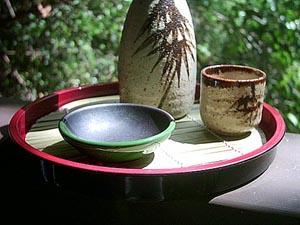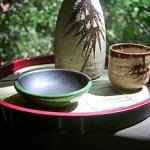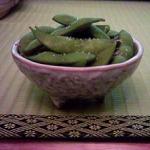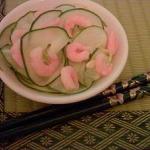'Firefly Dreams' Japanese Recipes & Photos
The menu to accompany the Japanese film 'Firefly Dreams' includes Sembei, Edamame, Sunomono, Miso Shiru, Sashimi, Zarusoba, Makizushi, Yakiniku, Tempura, and Peaches Marinated in Sake.
Sembei
Sembei is the Japanese word for rice crackers. These tasty little tidbits are the perfect start for any Japanese meal. They come in an amazing variety of sizes, shapes and flavors. Some are glazed with soy sauce, others are dusted with wasabi powder, and still others are wrapped in nori seaweed paper. The best thing is that they're so light, they won't spoil your appetite. Sembei can be purchased in most upscale grocery stores or in Asian food markets.
Edamame
1 package frozen soybeans (or one bunch fresh soybeans)
2 quarts water
1 tablespoon coarse salt
Bring water to a boil in a large kettle. Add soybeans and boil for 5 to 7 minutes, until tender. Drain in a colander, place in a bowl and sprinkle with coarse salt. Chill for 1 hour, and serve as an appetizer.
Sunomono (4 to 8 servings)
A favorite way to begin a Japanese meal is with a light vinegared salad made with cucumbers and other fresh vegetables in a simple marinade of rice wine vinegar, soy sauce and a few drops of sesame oil. The word sunomono means 'vinegared things' and can be prepared with almost any combination of ingredients, from fresh raw vegetables and greens to finely diced seafoods such as crab, octopus, or shrimp and sprinkled with sesame seeds. Here's a tasty and easy to prepare sunomono recipe:
1 Large cucumber
1 cup precooked bay shrimp
Wash a large cucumber and trim off the ends. Using a mandolin or very sharp knife, slice the cucumber into paper-thin slices and place in a bowl. Add one cup of tiny pre-cooked bay shrimp and marinate for 2 hours (stirring occasionally) in Rice Wine Vinegar Dressing:
1/2 cup Rice Wine Vinegar
1/4 cup mirin or sake
1 tablespoon sesame oil
Thoroughly mix and serve the sunomono in small individual dishes with a slotted spoon to drain off excess marinade. Garnish with a pinch of pickled ginger and sprinkle with sesame seeds.
Basic Dashi
Dashi is the clear seafood broth that is the foundation for many Japanese soups, sauces, dips, and marinades. To make one quart of dashi, you will need:
1 quart of water
1 4" piece of dried konbu (dried sea kelp)
1 cup of katsuo (dried bonito shavings)
Rinse or wipe the dusty coating from the surface of the konbu, place in a pot with one quart of water and cook over high heat. When the water comes to a boil remove and discard the konbu.
Add the katsuo flakes and bring to a boil again. Remove the pan from the heat and allow it to cool. Strain the liquid into a separate container and discard the katsuo and kombu.
The remaining liquid is called dashi and can be used as a base to make a wide variety of Japanese soups and sauces.
Miso Soup (Serves 4)
Japanese soups tend to be light and clear, made with a soup base called dashi. This basic stock is the foundation for Japan's most common soup, miso shiru, which consists of dashi, miso paste, flakes of dried wakame seaweed, and cubes of firm tofu.
1 quart of dashi
4 tbsp miso paste
1 tbsp dried wakame seaweed flakes, finely chopped
1 cup of tofu cut into ½" cubes
Bring the dashi to a boil in a large saucepan. Add the miso paste and stir with a wooden spoon until it dissolves completely. Bring the mixture just to a boil again and remove from the heat. Add the tofu cubes and wakame. Allow to stand for 5 minutes before serving. Ladle the soup into small bowls, stirring as you ladle to making sure that the miso, tofu cubes and wakame are well distributed between the portions.
Zarusoba (Serves 4)
6 ounces of soba noodles
1 cup ponzu
2 tablespoons wasabi powder
4 large prawns, deveined, shells intact
Bring two quarts of water to a boil in a large saucepan. Place prawns in boiling water for about 2 minutes, or until just pink and tender. Remove from water and drain. Set aside to cool.
Using the same boiling water, add soba noodles and simmer for 3-5 minutes, until just tender, being careful not to overcook. Drain noodles, dress with ponzu sauce and place in the refrigerator for about 1 hour to chill.
In a small bowl or ramekin, mix wasabi powder with a few drops of water and stir until it forms a thick paste. Set aside. Peel the prawns, leaving tails intact.
Divide the noodles and ponzu sauce into four serving dishes. Place one prawn on top of each serving and garnish with a pinch of wasabi paste rolled into a ball. Serve cold.
Sushi
Sushi, perhaps the most widely recognized of all Japanese food, is the categorical term for a variety of dishes made with vinegared rice. Sushi can be made with a countless array of seafoods and vegetables. Everyone has his or her own favorites. Just be sure that the ingredients you choose are absolutely the best and freshest available.
Sushi Rice
3 cups dry white sushi-grade rice (medium or short grain)
3 cups water
1/3 cup rice wine vinegar
2 tbsp sugar
1 tsp salt
Cook the rice in an automatic rice steamer, or use the stovetop instructions on the package. When the rice is done, dissolve the sugar and salt in the rice wine vinegar in a small pan over low heat. Sprinkle the vinegar mixture into the cooked rice and fluff gently with a wooden rice paddle to mix.
Place the cooked rice in a large wooden bowl or spread on a baking sheet to cool. Fan the rice with a pleated fan or piece of stiff paper for 8 to 10 minutes. This will produce an attractive sheen and helps keep the rice sticky. When the rice is cool to the touch, you can begin using it to make sushi.
Maguro Nigiri (24 pieces)
½ pound fresh tuna
2 cups sushi rice (see recipe)
2 tbsp wasabi paste (optional)
Pickled ginger
Soy sauce
With a very sharp knife, cut the fresh tuna into uniform 1"x2" slices about ¼" thick. If desired, rub a pinch of wasabi paste down the center of each slice.
With your left hand, scoop up enough sushi rice to fill the center of your palm. With the index and middle fingers of your right hand, press and shape the sushi rice into a tight oblong ball. If the rice sticks to your hands and fingers, moisten them with a little water or rice vinegar before handling the rice.
Lay a slice of tuna across the rice ball and place the sushi on an attractive serving dish. Garnish with a mound of pickled ginger, a ball of wasabi paste and serve with soy sauce for dipping.
Tekka Maki - Tuna Rolls (24 pieces)
2 cups sushi rice (see recipe)
4 oz fresh tuna, sliced into 1/2" strips
4 sheets of nori seaweed wrapper
1 tsp wasabi paste
Lay a 12x12" sheet plastic of wrap on a flat dry surface, such as a cutting board or countertop. Place a sheet of nori on the plastic wrap.
Cover the lower half of the nori with a thin layer of sushi rice, pressing firmly and distributing evenly all the way out to the left and right edges.
With your right thumb, rub a pinch of wasabi paste on the nori across the top edge of the rice.
Lay several strips of tuna, end-to-end, across the center of the rice.
Moisten the upper edge of the nori with a few drops of water.
Starting at the bottom edge, begin firmly but gently rolling the nori cigar style around the strips of tuna. Continue rolling to the moistened upper edge.
Fold the plastic wrap upward around the sushi roll and squeeze firmly along the length of the roll to compact the filling and seal the moistened edge of the nori.
Remove the plastic wrap and cut the sushi roll into 6 uniform pieces. Repeat the process with the remaining ingredients.
Stand each set of sushi rolls upright on an attractive serving dish and garnish with a ball of wasabi paste and a mound of pickled ginger.
Stuffed Cucumber
1 whole cucumber, washed, trimmed & pared every 1/4 inch
1 tablespoon coarse salt
1/2 cup tiny bay shrimp or lump crabmeat
1/4 cup finely grated carrot
1/4 cup sushi ginger
Wash cucumber, trim ends and pare away the peel every 1/4 inch. Place cucumber on a large plate, sprinkle with salt, coating all sides evenly. Allow to cure for about 1 hour. Rinse thoroughly to remove salt. Using a boning knife or long handled cocktail spoon, carefully scoop out the seeds to form a hollow tube through the center. Cut the cucumber lengthwise along one side only to access the center channel, and open gently to receive filling. Distribute shrimp or crabmeat, grated carrot and sushi ginger evenly along the length of the center, making sure to fully fill the channel. Squeeze gently to close the seam and roll tightly in plastic wrap. Chill for 1 hour. To serve, slice into 1/4" rounds and arrange on an attractive serving dish.
Yakiniku over Spinach Salad (Serves 4)
These grilled skewered treats are a favorite at tiny neighborhood yakitori stands and at outdoor festivals. The meat can be skewered by itself, or with cubed vegetables such as onions, bell peppers and mushrooms.
1 pound tender beef (sirloin, filet mignon, tri-tip, etc)
½ cup mild soy sauce
½ cup mirin or sake
1 tbsp freshly grated ginger
2 tbsp brown sugar
4 bamboo 12" skewers
Soak the bamboo skewers in water for 15 minutes to prevent them from splintering and burning.
Combine the soy sauce, mirin, ginger and brown sugar and mix thoroughly.
Cut the beef into 1" cubes and marinate for 30 minutes in the soy sauce mixture.
Assemble the skewers.
Grill beef skewers to desired doneness on an electric grill or an outdoor barbeque (2-3 minutes per side). Serve over spinach salad (see recipe below). Skewers may be cut in half for smaller grills), You can also place skewers on a baking sheet, baste with the remaining marinade and broil in a 350-degree oven for 12 to 15 minutes, basting every 5 minutes.
Spinach Salad
1 bunch fresh spinach leaves
1/4 cup soy sauce
1/4 cup rice vinegar
1/4 cup sesame oil
1 teaspoon wasabi powder
Combine soy sauce, rice vinegar, sesame oil and wasabi powder in a jar with a tight-fitting lid. Shake vigorously to blend. Place spinach leaves in a large bowl. Add desired amount of dressing. Toss to coat. Place on an attractive serving dish and serve yakiniku skewers on top.
Tempura (4 servings)
The technique of frying foods in oil was first introduced to Japan by Portuguese traders over 400 years ago. Japanese culinary masters have since perfected it into a highly evolved edible art form. This delicately battered treat requires skill and concentration, but don't let that stop you from trying it in your own kitchen.
Traditional ingredients for cooking tempura style include large prawns, white fish such as snapper or halibut, Japanese pumpkin, bell peppers, carrots, mushrooms, onion rings, broccoli spears, zucchini, green beans, and shizo leaf. All items should be sliced into thin pieces that can be quickly cooked and easily eaten.
8 large prawns, peeled and de-veined
½ pound of halibut, snapper or other white fish fillets cut into 1" slices
1 bell pepper cut into ¼" rings
1 yellow onion cut into ¼" rings
8 mushrooms, washed and trimmed
1 carrot cut into 1"x4" slices 1/8" thick
1 Japanese pumpkin, peeled and cut into ¼" slices
1 cup white flour for dredging
Vegetable oil for frying
Tempura Batter:
2 egg yolks
2 cups white flour
2 cups ice water
(or you can use a tempura batter mix)
Tentsuyu Dipping Sauce:
1 cup dashi (see recipe above)
3 tbsp soy sauce
3 tbsp mirin
1 tbsp freshly grated daikon radish
1 tbsp freshly grated ginger
To Prepare the Tempura:
First, combine all tentsuyu ingredients, mix thoroughly and spoon into small individual dishes (one for each guest) so that the dipping sauce is ready when the tempura is served. For a more interesting and attractive presentation, you can also combine only the liquid ingredients and serve the daikon and ginger in little mounds on a separate condiment dish for the guests to mix in themselves.
Next, combine all the batter ingredients, being careful not to overmix. It's okay if the batter is a little lumpy. Work quickly so the batter stays chilled. If necessary, you can divide the batter into two bowls and store one in the fridge until needed.
Dredge all the seafood and vegetables in flour. A good way to do this is to place the flour in a small plastic or paper bag with the fish and vegetables. Shake gently to coat. You can also scatter the flour on a large plate and drag the items through it.
Fill a large wok about half full of vegetable oil and heat to 370 degrees. A good way to test the readiness of your oil is to dribble a few drops of batter into it. If the batter sizzles and floats, it's ready.
Dip one piece of fish or vegetable at a time in the tempura batter. Hold each piece over the bowl to allow the excess batter to drain off and slip them into the hot oil, being careful not to splatter. You can use a fork or a pair of chopsticks for this step, but fingers work just as well.
Do not overfill the wok. Each batch should contain no more than 6 or 8 pieces. The chilled tempura batter should explode into a lacy crust that will turn a pale, golden brown in about 3 minutes.
When crispy and tender, remove the tempura from the oil with a pair of tongs or a slotted spoon and place on paper towels to drain.
Before adding the next batch of tempura, skim and discard the loose bits of batter from the cooking oil so they do not burn. Work quickly and serve the tempura on a large platter, or place a variety of each fish and vegetable on individual plates. Tempura may also be kept warm for a short while on a baking dish in a 200 degree oven until serving time.
Japanese White Rice (Serves 4)
2 cups medium grain rice
2 ½ cups water
Thoroughly rinse the rice in a sieve until the rinse water runs clear. Place the rice and the water in a heavy kettle or saucepan and allow to stand for 30 minutes. Bring to a boil, cover and cook 15 to 20 minutes, or until water is absorbed. Reduce the heat and simmer for another 5 minutes. Remove from the heat and let the rice stand for 10 minutes. Uncover and fluff the rice with chopsticks or a wooden rice paddle. Serve immediately.
Peaches Marinated in Sake
3 ripe peaches (the white-fleshed Asian variety are best)
1 cup Japanese sake (rice wine)
2 tablespoons sugar (optional, especially if peaches are very sweet)
Several sprigs of fresh mint
Wash and slice the peaches into thin crescents. Combine with sake and sugar in a container with a tight fitting lid. Shake gently to combine. Chill in the refrigerator for two hours, or overnight. Serve on an attractive dish with candied ginger and a sprig of fresh mint. The leftover sake makes a delicious and unusual fruit-infused after-dinner wine.
Japanese Green Tea (4 servings)
The green tea that the Japanese people drink on a daily basis is quite different from the tea used in the Japanese Tea Ceremony. Ocha, everyday tea, is made from loose dried tea leaves, which are available in several grades of quality, while tea ceremony tea is an intensely flavorful powdered tea that makes a frothy foam when it is whisked in hot water. Here's how to make a pot of everyday ocha:
4 cups hot water (190 degrees F, just below boiling point)
5 tablespoons green tea leaves
Place the loose tea leaves into a teapot. Add water. Steep for 3 to 5 minutes. Pour into mugs and serve hot.
 ThingsAsian
ThingsAsian


















